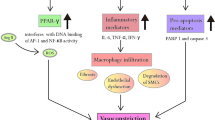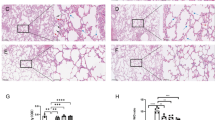Abstract
Hydrogen sulphide (H2S) is an endogenous inflammatory mediator produced by cystathionine-γ-lyase (CSE) in monocytes/macrophages. To determine the role of H2S and macrophages in inflammation, we used small interference RNA (siRNA) to target the CSE gene and investigated its effect in a mouse model of acute pancreatitis. Acute pancreatitis is characterised by increased levels of plasma amylase, myeloperoxidase (MPO) activity and pro-inflammatory cytokines and chemokines in the pancreas and lung. SiRNA treatment attenuated inflammation in the pancreas and lungs of mice following caerulein-induced acute pancreatitis. MPO activity increased in caerulein-induced acute pancreatitis (16.21 ± 3.571 SD fold increase over control) and treatment with siRNA significantly reduced this (mean 3.555 ± 2.522 SD fold increase over control) (p < 0.0001). Similarly, lung MPO activity increased following treatment with caerulein (3.56 ± 0.941 SD fold increase over control) while siRNA treatment significantly reduced MPO activity (0.8243 ± 0.4353 SD fold increase over control) (p < 0.0001). Caerulein treatment increased plasma amylase activity (7094 ± 207 U/l) and this significantly decreased following siRNA administration (5895 ± 115 U/l) (p < 0.0001). Cytokine and chemokine levels in caerulein-induced acute pancreatitis reduced following treatment with siRNA. For example, siRNA treatment significantly decreased pancreatic and lung monocyte chemoattractant protein (MCP)-1 (169.8 ± 59.75 SD; 90.01 ± 46.97 SD pg/ml, respectively) compared to caerulein-treated mice (324.7 ± 103.9 SD; 222.8 ± 85.37 SD pg/ml, pancreas and lun,g respectively) (p < 0.0001). These findings show a crucial pro-inflammatory role for H2S synthesised by CSE in macrophages in acute pancreatitis and suggest CSE gene silencing with siRNA as a potential therapeutic approach for this condition.








Similar content being viewed by others
References
Ang AD, Rivers-Auty J, Hegde A, Ishii I, Bhatia M (2013) The effect of CSE gene deletion in caerulein-induced acute pancreatitis in the mouse. Am J Physiol Gastrointest Liver Physiol 305(10):G712–21. doi:10.1152/ajpgi.00044.2013
Badiei A, Rivers-Auty J, Ang AD, Bhatia M (2013) Inhibition of hydrogen sulfide production by gene silencing attenuates inflammatory activity of LPS-activated RAW264.7 cells. Appl Microbiol Biotechnol 97(17):7845–52. doi:10.1007/s00253-013-5080-x
Badiei A, Muniraj N, Chambers S, Bhatia M (2014) Inhibition of hydrogen sulfide production by gene silencing attenuates inflammatory activity by downregulation of NF-κB and MAP kinase activity in LPS-activated RAW 264.7 cells. Biomed Res Int 2014:7. doi:10.1155/2014/848570
Bhatia M, Hegde A (2007) Treatment with antileukinate, a CXCR2 chemokine receptor antagonist, protects mice against acute pancreatitis and associated lung injury. Regul Pept 138(1):40–8. doi:10.1016/j.regpep.2006.08.006
Bhatia M, Brady M, Zagorski J, Christmas SE, Campbell F, Neoptolemos JP, Slavin J (2000) Treatment with neutralising antibody against cytokine induced neutrophil chemoattractant (CINC) protects rats against acute pancreatitis associated lung injury. Gut 47(6):838–44
Bhatia M, Slavin J, Cao Y, Basbaum AI, Neoptolemos JP (2003) Preprotachykinin-A gene deletion protects mice against acute pancreatitis and associated lung injury. Am J Physiol Gastrointest Liver Physiol 284(5):G830–6. doi:10.1152/ajpgi.00140.2002
Bhatia M, Ramnath RD, Chevali L, Guglielmotti A (2005a) Treatment with bindarit, a blocker of MCP-1 synthesis, protects mice against acute pancreatitis. Am J Physiol Gastrointest Liver Physiol 288(6):G1259–65. doi:10.1152/ajpgi.00435.2004
Bhatia M, Sidhapuriwala J, Moochhala SM, Moore PK (2005b) Hydrogen sulphide is a mediator of carrageenan-induced hindpaw oedema in the rat. Br J Pharmacol 145(2):141–4. doi:10.1038/sj.bjp.0706186
Bhatia M, Wong FL, Fu D, Lau HY, Moochhala SM, Moore PK (2005c) Role of hydrogen sulfide in acute pancreatitis and associated lung injury. FASEB J 19(6):623–5. doi:10.1096/fj.04-3023fje
Brady M, Bhatia M, Christmas S, Boyd MT, Neoptolemos JP, Slavin J (2002) Expression of the chemokines MCP-1/JE and cytokine-induced neutrophil chemoattractant in early acute pancreatitis. Pancreas 25(3):260–9
Burnett G, Marcotte P, Walsh C (1980) Mechanism-based inactivation of pig heart L-alanine transaminase by L-propargylglycine. Half-site reactivity. J Biol Chem 255(8):3487–91
Collin M, Anuar FB, Murch O, Bhatia M, Moore PK, Thiemermann C (2005) Inhibition of endogenous hydrogen sulfide formation reduces the organ injury caused by endotoxemia. Br J Pharmacol 146(4):498–505. doi:10.1038/sj.bjp.0706367
Frossard JL, Pastor CM (2002) Experimental acute pancreatitis: new insights into the pathophysiology. Front Biosci 7:d275–87
Leser HG, Gross V, Scheibenbogen C, Heinisch A, Salm R, Lausen M, Ruckauer K, Andreesen R, Farthmann EH, Scholmerich J (1991) Elevation of serum interleukin-6 concentration precedes acute-phase response and reflects severity in acute pancreatitis. Gastroenterology 101(3):782–5
Leuschner F, Dutta P, Gorbatov R, Novobrantseva TI, Donahoe JS, Courties G, Lee KM, Kim JI, Markmann JF, Marinelli B, Panizzi P, Lee WW, Iwamoto Y, Milstein S, Epstein-Barash H, Cantley W, Wong J, Cortez-Retamozo V, Newton A, Love K, Libby P, Pittet MJ, Swirski FK, Koteliansky V, Langer R, Weissleder R, Anderson DG, Nahrendorf M (2011) Therapeutic siRNA silencing in inflammatory monocytes in mice. Nat Biotechnol 29(11):1005–10. doi:10.1038/nbt.1989
Li L, Bhatia M, Zhu YZ, Zhu YC, Ramnath RD, Wang ZJ, Anuar FB, Whiteman M, Salto-Tellez M, Moore PK (2005) Hydrogen sulfide is a novel mediator of lipopolysaccharide-induced inflammation in the mouse. FASEB J 19(9):1196–8. doi:10.1096/fj.04-3583fje
Li L, Whiteman M, Moore PK (2009) Dexamethasone inhibits lipopolysaccharide-induced hydrogen sulphide biosynthesis in intact cells and in an animal model of endotoxic shock. J Cell Mol Med 13(8B):2684–92. doi:10.1111/j.1582-4934.2008.00610.x
Liang T, Liu TF, Xue DB, Sun B, Shi LJ (2008) Different cell death modes of pancreatic acinar cells on macrophage activation in rats. Chin Med J 121(19):1920–4
Marcotte P, Walsh C (1976) Vinylglycine and proparglyglycine: complementary suicide substrates for L-amino acid oxidase and D-amino acid oxidase. Biochemistry 15(14):3070–6
Norman JG, Fink GW, Franz MG (1995) Acute pancreatitis induces intrapancreatic tumor necrosis factor gene expression. Arch Surg 130(9):966–70
Norman JG, Fink GW, Messina J, Carter G, Franz MG (1996) Timing of tumor necrosis factor antagonism is critical in determining outcome in murine lethal acute pancreatitis. Surgery 120(3):515–21
Pastor CM, Rubbia-Brandt L, Hadengue A, Jordan M, Morel P, Frossard JL (2003) Role of macrophage inflammatory peptide-2 in cerulein-induced acute pancreatitis and pancreatitis-associated lung injury. Lab Invest 83(4):471–8
Pezzilli R, Miniero R, Cappelletti O, Barakat B (1998) Serum interleukin 6 in the prognosis of acute biliary pancreatitis. Ital J Gastroenterol Hepatol 30(3):291–4
Rau B, Baumgart K, Kruger CM, Schilling M, Beger HG (2003) CC-chemokine activation in acute pancreatitis: enhanced release of monocyte chemoattractant protein-1 in patients with local and systemic complications. Intensive Care Med 29(4):622–9. doi:10.1007/s00134-003-1668-4
Shen Y, Cui NQ (2012) Clinical observation of immunity in patients with secondary infection from severe acute pancreatitis. Inflamm Res 61(7):743–8. doi:10.1007/s00011-012-0467-1
Shen Y, Cui N, Miao B, Zhao E (2011) Immune dysregulation in patients with severe acute pancreatitis. Inflammation 34(1):36–42. doi:10.1007/s10753-010-9205-4
Sun J, Bhatia M (2007) Blockade of neurokinin-1 receptor attenuates CC and CXC chemokine production in experimental acute pancreatitis and associated lung injury. Am J Physiol Gastrointest Liver Physiol 292(1):G143–53. doi:10.1152/ajpgi.00271.2006
Swirski FK, Nahrendorf M, Etzrodt M, Wildgruber M, Cortez-Retamozo V, Panizzi P, Figueiredo JL, Kohler RH, Chudnovskiy A, Waterman P, Aikawa E, Mempel TR, Libby P, Weissleder R, Pittet MJ (2009) Identification of splenic reservoir monocytes and their deployment to inflammatory sites. Science 325(5940):612–6. doi:10.1126/science.1175202
Tamizhselvi R, Moore PK, Bhatia M (2007) Hydrogen sulfide acts as a mediator of inflammation in acute pancreatitis: in vitro studies using isolated mouse pancreatic acinar cells. J Cell Mol Med 11(2):315–26. doi:10.1111/j.1582-4934.2007.00024.x
Tamizhselvi R, Moore PK, Bhatia M (2008) Inhibition of hydrogen sulfide synthesis attenuates chemokine production and protects mice against acute pancreatitis and associated lung injury. Pancreas 36(4):e24–31. doi:10.1097/MPA.0b013e31816857bb
Viedma JA, Perez-Mateo M, Dominguez JE, Carballo F (1992) Role of interleukin-6 in acute pancreatitis. Comparison with C-reactive protein and phospholipase A. Gut 33(9):1264–7
Yan XT, Tumpey TM, Kunkel SL, Oakes JE, Lausch RN (1998) Role of MIP-2 in neutrophil migration and tissue injury in the herpes simplex virus-1-infected cornea. Invest Ophthalmol Vis Sci 39(10):1854–62
Yasuda T, Takeyama Y, Ueda T, Takase K, Nishikawa J, Kuroda Y (2002) Splenic atrophy in experimental severe acute pancreatitis. Pancreas 24(4):365–72
Zhang H, Zhi L, Moore PK, Bhatia M (2006) Role of hydrogen sulfide in cecal ligation and puncture-induced sepsis in the mouse. Am J Physiol Lung Cell Mol Physiol 290(6):L1193–201. doi:10.1152/ajplung.00489.2005
Zhang J, Sio SW, Moochhala S, Bhatia M (2010) Role of hydrogen sulfide in severe burn injury-induced inflammation in mice. Mol Med 16(9–10):417–24. doi:10.2119/molmed.2010.00027
Acknowledgments
This work was supported by the Maurice and Phyllis Paykel Trust grant number 110443.01.Q.PZ and Infection Research Group (Department of Pathology, University of Otago, Christchurch) (Professor Stephen Chambers).
Conflict of interest
The authors declare that they have no competing interests.
Compliance with ethical standards
All experimental procedures were approved by the animal ethics committee of the University of Otago, Christchurch, New Zealand.
Author information
Authors and Affiliations
Corresponding author
Rights and permissions
About this article
Cite this article
Badiei, A., Chambers, S.T., Gaddam, R.R. et al. Cystathionine-gamma-lyase gene silencing with siRNA in monocytes/macrophages protects mice against acute pancreatitis. Appl Microbiol Biotechnol 100, 337–346 (2016). https://doi.org/10.1007/s00253-015-6989-z
Received:
Revised:
Accepted:
Published:
Issue Date:
DOI: https://doi.org/10.1007/s00253-015-6989-z




